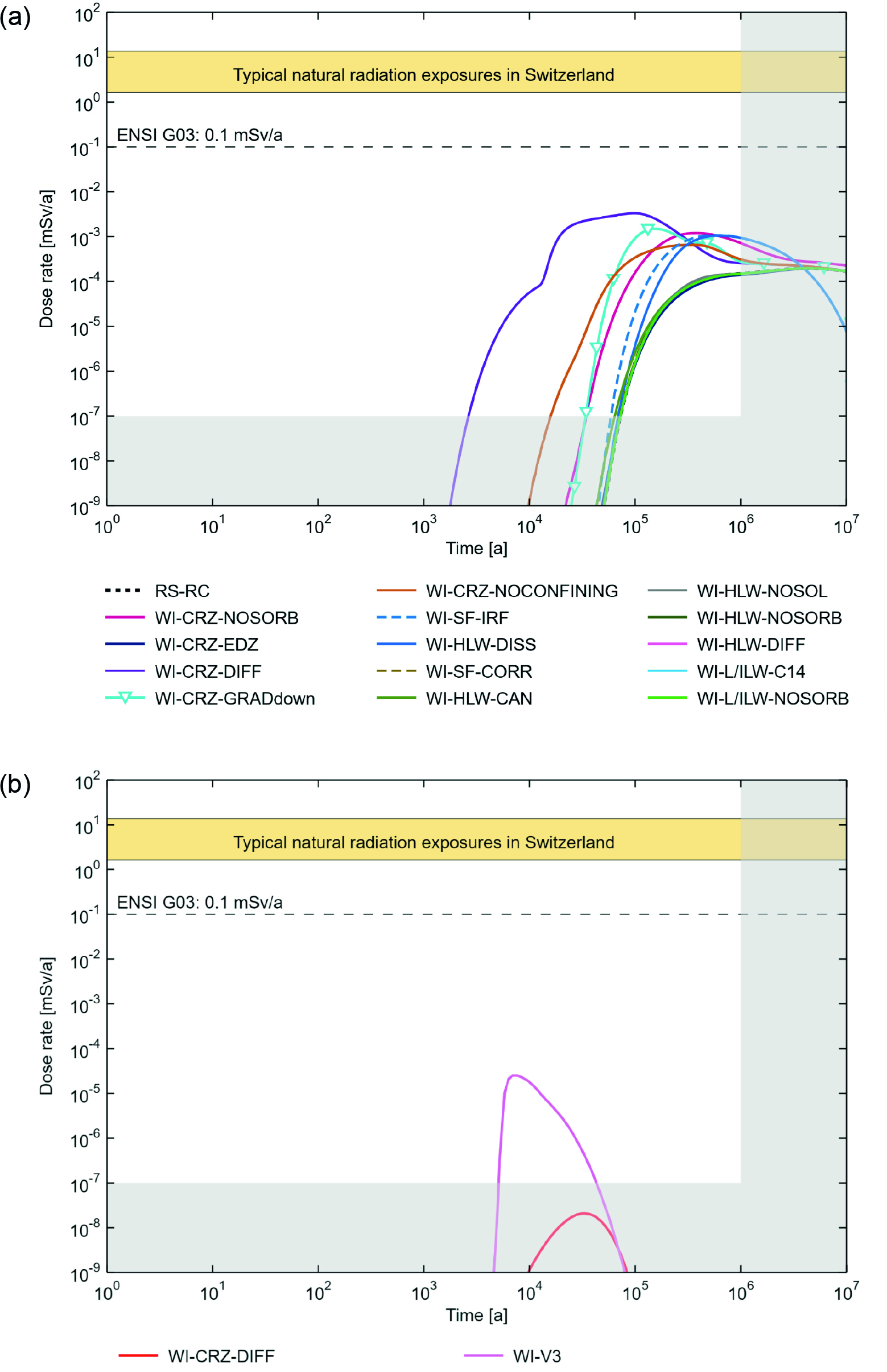Further “what-if?” cases are defined by systematically going through the pillars of safety and either removing them or assuming a degradation of the safety function they serve. The calculation cases as identified in the scenario development are summarised in Tab. 8‑8 (see Section 7.4 for details and illustrations). Tab. 8‑8 also indicates which radionuclide transport pathways are considered for which calculation case. On the one hand, calculation cases that impact mainly the flow along the underground structures, i.e., linked to the closure system or the permeability of the bentonite buffer, are only calculated for the two-phase flow and transport since the aqueous phase transport is dominated by diffusion through the CRZ. On the other hand, calculation cases that obviously do not significantly impact two-phase flow and release or the transport of 14C as methane are only computed for the aqueous phase. This concerns hypothetical assumptions of no sorption or solubility limits, hypothetically high dissolution rates for spent fuel or the glass matrix of reprocessed waste, and also hypothetically high diffusion coefficients in the bentonite buffer. Finally, the calculation case with a hypothetically high upwardly directed hydraulic gradient would lead to lower doses for the aqueous phase transport since the dominating transport path for radionuclides is downwards.
Tab. 8‑8:“What-if?” cases with hypothetically degraded performance of pillars of safety
|
Pillar of safety |
Case |
Transport modelling approach |
Description |
|
|
Aqueous phase |
Two-phase |
|||
|
CRZ |
WI-CRZ-NOSORB |
✓ |
× |
No geosphere sorption |
|
WI-CRZ-EDZ |
✓ |
✓ |
Hypothetically high radial dimension of EDZ around emplacement rooms |
|
|
WI-CRZ-DIFF |
✓ |
✓ |
Hypothetically high diffusion coefficients in the geosphere (In the modelling for two-phase flow, the diffusion coefficient for 14C is hypothetically increased as well) |
|
|
WI-CRZ-GRADdown |
✓ |
✓ |
Hypothetically high downwardly directed hydraulic gradient |
|
|
WI-CRZ-GRADup |
× |
✓ |
Hypothetically high upwardly directed hydraulic gradient |
|
|
WI-CRZ-NOCONFINING |
✓ |
✓ |
Upper and lower confining geological units disregarded |
|
|
HLW matrices |
WI-SF-IRF |
✓ |
✓ |
Hypothetically high instant release fractions (IRFs) for radionuclides in SF |
|
WI-HLW-DISS |
✓ |
× |
Hypothetically high matrix dissolution rates for SF and RP-HLW |
|
|
WI-SF-CORR |
✓ |
✓ |
Hypothetically high corrosion rates of SF cladding and other structural parts |
|
|
HLW disposal canister |
WI-HLW-CAN |
✓ |
✓ |
Hypothetical early failure of all HLW canisters at 1,000 years |
|
Bentonite buffer (HLW) |
WI-HLW-NOSOL |
✓ |
× |
No near-field solubility limits in HLW repository section |
|
WI-HLW-NOSORB |
✓ |
× |
No near-field sorption in HLW repository section |
|
|
WI-HLW-DIFF |
✓ |
× |
Hypothetically high diffusion coefficients in bentonite buffer |
|
|
Bentonite buffer (HLW) |
WI-HLW-BUF |
× |
✓ |
Hypothetically high permeability of bentonite buffer in HLW drifts |
|
L/ILW cementitious near field |
WI-L/ILW-C14 |
✓ |
✓ |
All 14C present in L/ILW released instantaneously |
|
WI-L/ILW-NOSORB |
✓ |
× |
No near-field sorption in L/ILW repository section |
|
|
Closure system |
WI-V1-HLW |
× |
✓ |
Hypothetically high permeability of V1-HLW seals |
|
WI-V1-L/ILW |
× |
✓ |
Hypothetically high permeability of V1-L/ILW seals |
|
|
WI-V2-HLW |
× |
✓ |
Hypothetically high permeability of V2-HLW seals |
|
|
WI-V2-L/ILW |
× |
✓ |
Hypothetically high permeability of V2-L/ILW seals |
|
|
WI-V3 |
× |
✓ |
Hypothetically high permeability of V3 seals |
|
The results in the form of dose rates for the “what-if`?” cases with hypothetically degraded pillars of safety are given in Fig. 8‑12 for both (a) the aqueous phase and (b) two-phase transport. For the aqueous phase results, the reference case is also shown for comparison (for two-phase transport, the dose rate for the reference case is negligible).
The aqueous phase results in Fig. 8‑12a show one calculation case with more than one order of magnitude higher maximum dose rates and considerably earlier releases than for the reference case; this is the calculation case of hypothetically high diffusion coefficients (WI-CRZ-DIFF).
Three calculation cases with hypothetically degraded performance of the CRZ lead to higher dose rates by up to about one order of magnitude and earlier releases than the reference case; this illustrates the importance of the geological barrier. These three calculation cases are (i) no geosphere sorption (WI-CRZ-NOSORB), (ii) the upper and lower confining geological units are disregarded (WI-CRZ-NOCONFINING) and (iii) a hypothetically high downwardly directed hydraulic gradient (WI-CRZ-GRADdown).
Two additional calculation cases also show approximately one order of magnitude higher dose rates compared with the reference case: (i) hypothetically high instant release fractions (IRFs) for radionuclides in SF (WI-SF-IRF) and (ii) hypothetically high matrix dissolution rates for SF and RP-HLW (WI-HLW-DISS).
All the other calculation cases for the aqueous phase have no impact on the dose rates.
For the two-phase flow results (Fig. 8‑12b) only the dose rates from two calculation cases are visible; one with a hypothetically high diffusion coefficient for 14C (WI-CRZ-DIFF) and one with a hypothetically high permeability of the V3 seals (WI-V3). Only WI-V3 gives rise to dose rates above 10-7 mSv/a.
Overall, the results of all the “what-if?” cases are well below the dose protection criterion, again confirming the robustness of the repository system.

Fig. 8‑12: Dose rates for the calculation cases for the “what-if?” cases with hypothetically degraded performance of pillars of safety and radionuclide transport in the aqueous phase (a) and for the two-phase transport of 14C (b)

